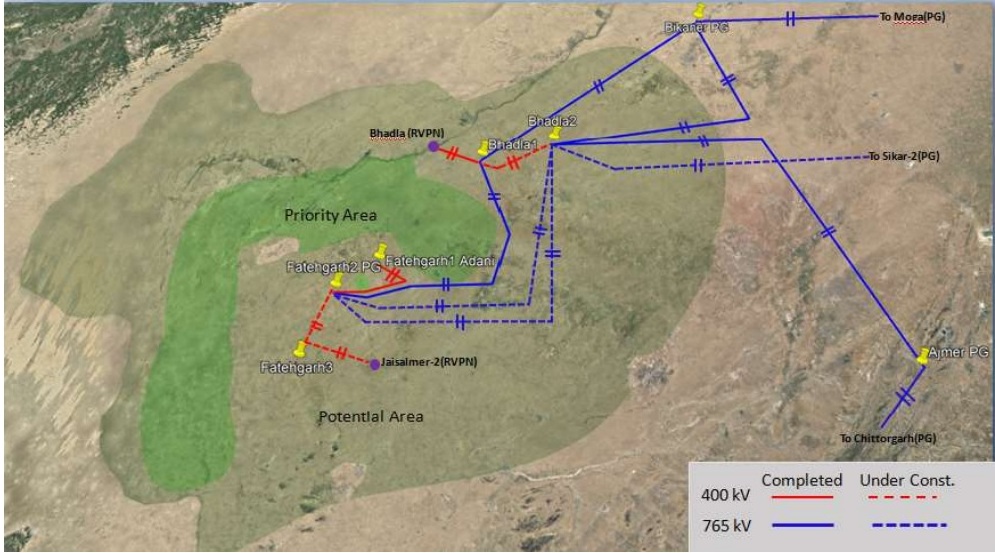Central Electricity Regulatory Commission (CERC) has given the liberty to Power Grid Corporation of India Ltd (PGCIL) to file fresh petitions for grant of transmission licence for three of its TBCB projects, after PGCIL has sought recommendations of a Supreme Court-appointed committee constituted in the context of protecting the Great Indian Bustard.
The three projects in question are all related to power transmission systems associated with evacuation of electricity from upcoming solar energy zones in Rajasthan. The project SPVs involved are:
- Fatehgarh Bhadla Transco Ltd
- Sikar New Transmission Ltd
- Sikar-II Aligarh Transmission Ltd
The contentious issue
The contentious issue in the grant of transmission licence is the presence of priority and potential habitats of the Great Indian Bustard (an endangered Indian bird species) in the command area of the transmission systems envisaged by the three aforementioned SPVs. It also includes the presence of such area in the geographical footprint of the upstream and downstream transmission systems associated with the three projects. These priority and potential GIB inhabitations are largely in Rajasthan.
In the first project, Fatehgarh Bhadla Transco Ltd, the entire transmission line falls in the potential habitat of GIB. In the case of Sikar New Transmission Ltd, 104 km out of the total 304 km of the transmission line is so affected. There is however no trespassing of GIB priority or potential habitat for Sikar-II Aligarh Transmission Ltd—the third project.
As far as the downstream infrastructure of the three projects is concerned, a significant amount of area covered by transmission lines and substations (either under construction or proposed) falls in the potential habitat of GIB.
Also read: CERC Grants Transmission Licence To Bikaner-II Bhiwadi Transco
Supreme Court ruling
In April 2021, the Supreme Court passed an important order with respect to all upcoming projects falling in the priority or potential habitats of GIB.
In general, the Supreme Court ruled that underground cables be laid, instead of overhead transmission lines. However, recognizing that such an alternative cannot be feasible for all projects, the Supreme Court appointed a technical committee to ascertain the feasibility of underground cabling, on a case-to-case basis. This committee comprises members of the Union ministry of new & renewable energy (MNRE), Wildlife Institute of India (WII) and the Corbett Foundation.
For existing transmission lines in priority and potential GIB habitations, the Supreme Court proposed the installation of bird diverters on transmission towers.
Power ministry study team
In June 2021, the Union power ministry constituted a study team comprising members of MNRE, PGCIL, GETCO, RVPL, CEA and WII, to formulate implementation of the Supreme Court order. On July 28, 2021, the study team submitted its report and made recommendations. In general, for both priority and potential GIB habitats, the study team has recommended that overhead lines of 66kV or above be exempt from underground cabling. Instead, bird diverters will be installed for such lines—both existing and upcoming. For 33kV lines however, the team has recommended underground cabling.
The 765kV dimension
The three projects of PGCIL under discussion involve 765kV lines. As such, it is impossible to lay such extra high-voltage lines underground as nowhere in the world are there underground cables of 765kV rating, as yet.
PGCIL, while submitting its petition for grant of transmission licence of the projects under discussion has said that it would comply with the recommendations of the power ministry study team and install bird diverters for all the 765kV lines that fall in the priority or potential GIB areas.
It is important to note here that PGCIL has not yet approached the committee appointed by the Supreme Court.
CERC, in its ruling admitted that there was no point in keeping the petitions (for transmission licence) pending indefinitely. All the same, the Supreme Court order of April 2021 could not be ignored. CERC has also said that though there is no priority or potential GIB habitation with respect to the Sikar-II Aligarh Transmission Ltd project, the commission would not like to deal with this project in isolation.
In view of the situation, though CERC has not allowed the petition of PGCIL, it has given PGCIL the liberty of approaching the commission with fresh petitions, after PGCIL has taken the required actions as stipulated in the Supreme Court order.
PGCIL’s petition to CERC sought grant of transmission licence and adoption of transmission charges for the three projects. This is a mandatory requirement for TBCB projects.
The next steps
Before PGCIL files a fresh petition for transmission licences for the three projects, it will need to approach the Supreme Court committee. According to some experts that T&D India got in touch with, the committee, in normal course, should accept the bird diverter alternative as laying 765kV lines underground is ruled out for all practical purposes. All the same, PGCIL would also need to expedite matters from its end because all the three projects have a stipulated completion time, as envisaged in the concession agreement. In this case, it is 18 months for all the three projects.
GIBs on the decline
(Featured illustration, sourced from CERC, shows completed and under-construction transmission lines in the priority and potential habitations of the Great Indian Bustard. Inside photograph (source: Britannica) shows a Great Indian Bustard in Rajasthan.)

